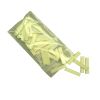YSI 6025 Chlorophyll Sensor
Features
- Fast, convenient, in-situ monitoring
- Self-wiping probe for long-term measurement
- Small field-replaceable probe design
- Expedited repair and warranty service
- Lifetime technical support
- More
Overview
The YSI 6025 Chlorophyll Probe expands YSI's suite of sensors for multi-parameter, water quality monitoring applications. The new probe is designed to estimate phytoplankton concentrations by detecting the fluorescence from chlorophyll in situ. The data can be useful in predicting detrimental algae blooms and, indirectly, in determining nutrient loading in environmental applications. The probe features a mechanical self-wiping capability for long-term monitoring.
Compact
The YSI 6025 Chlorophyll Probe uses technology similar to that used by fluorometers, but the YSI sensor is much smaller, making it compatible with the probe ports in YSI's 6-Series instruments, including the YSI 6600 & 6600 V2 as well as the YSI 6820, 6820 V2, 6920, & 6920 V2. The YSI 6600 V2 sonde allows simultaneous measurement of four optical probes (dissolved oxygen, turbidity, chlorophyll, blue-green algae, and/or rhodamine), along with other parameters. The YSI 6820 V2 and 6920 V2 allow the measurement of two optical probes, along with many other parameters.
Simplified Sampling
Before the new YSI sensor made in situ measurement convenient, the common way to measure chlorophyll was to collect samples and use extractive analysis in a laboratory or take large equipment to the field. Extractive analysis methods, though highly accurate, are time-consuming and require an experienced analyst. The YSI optical, fluorescence probe is quick and efficient to use. The YSI 6025 Chlorophyll Probe enables spot sampling in remote areas as well as continuous or interval monitoring.
- Range: ~0 to 400 ug/L; 0 to 100 RFU
- Detection Limit: ~0.1 ug/L
- Resolution: 0.1 ug/L Chl; 0.1% RFU
- Linearity: R2> 0.9999
- Warranty: 2 years
In The News
Plankton Portal enlists public to classify thousands of zooplankton images
Zooplankton drifts through the ocean, often ignored by the public in favor of more charismatic marine organisms farther up the food chain. A new crowdsourced project aims to change that, giving anyone a closer look at small and intricate zooplankton. PlanktonPortal.org features 900,000 high resolution images of zooplankton and tasks the public to identify them as part of data processing for a collaborative study, based out of the University of Miami Rosenstiel School of Marine and Atmospheric Science. Researchers hope the project will tell them more about zooplankton behavior, grouping and interaction.
Read MoreStone Laboratory to open new algae focused water quality lab
Ohio State University’s Stone Laboratory will open a new lab this summer focused on algae and water quality, according to the Ohio Sea Grant magazine Twine Line. The new laboratory will be in the Stone Lab Research Building on Lake Erie’s South Bass Island. Many instruments and tests will be accessible at the lab to evaluate all functions of algal blooms from photosynthesis to nutrient consumption. The lab will enable scientists to test phytoplankton, water and sediment samples on the lake instead of sending them away. This should save researchers time and money in the long run. Lab administrators hope to increase collaborations with other research organizations and government agencies through the creation of the new laboratory.
Read MoreSpring 2025 Environmental Monitor Available Now
In the Spring 2025 edition of the Environmental Monitor, we highlight partnerships across the world and the importance of collaboration between government agencies, universities, environmental groups, local communities, and other stakeholders. From great white shark research in Cape Cod to monitoring fisheries in Lake Erie, this latest edition underscores partnerships that connect stakeholders in a watershed through environmental data. With an emphasis on data sharing, a combination of real-time and discrete sampling keeps the public and partners informed of environmental conditions. Our writers also sought out science professionals dedicated to working with peers within and outside of the environmental sector.
Read More










